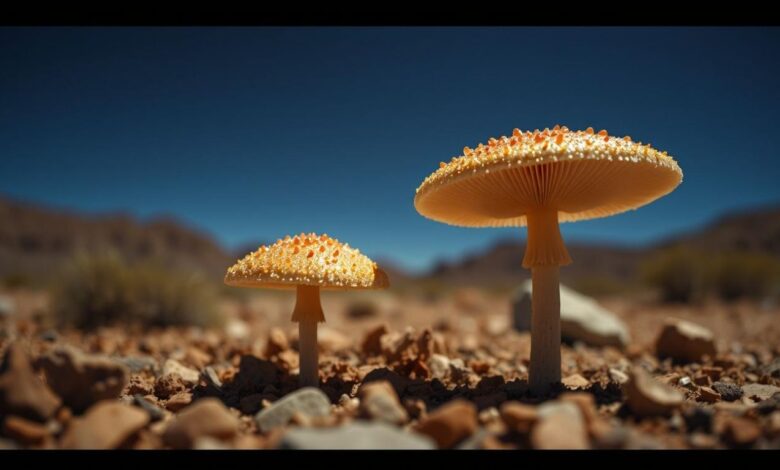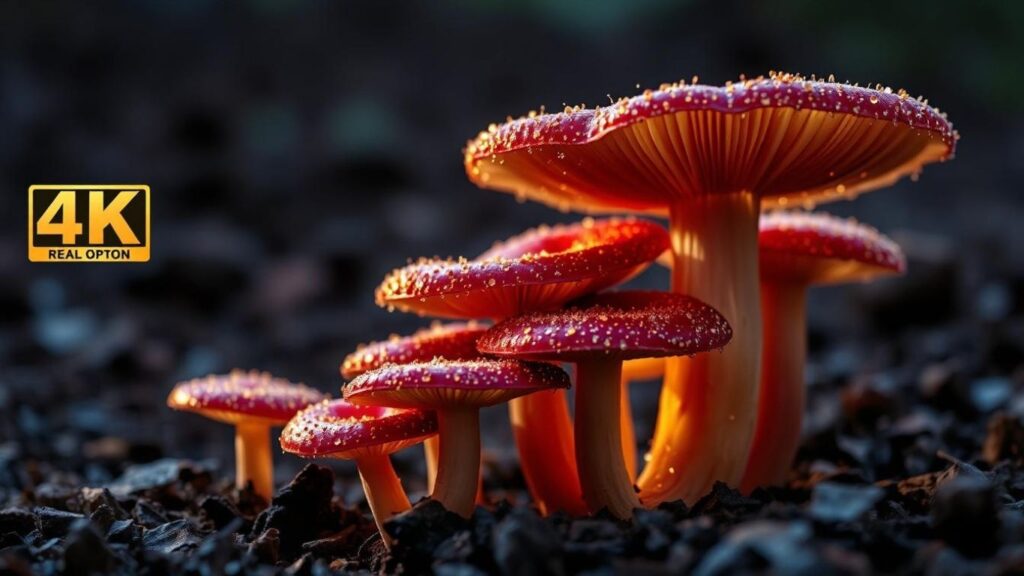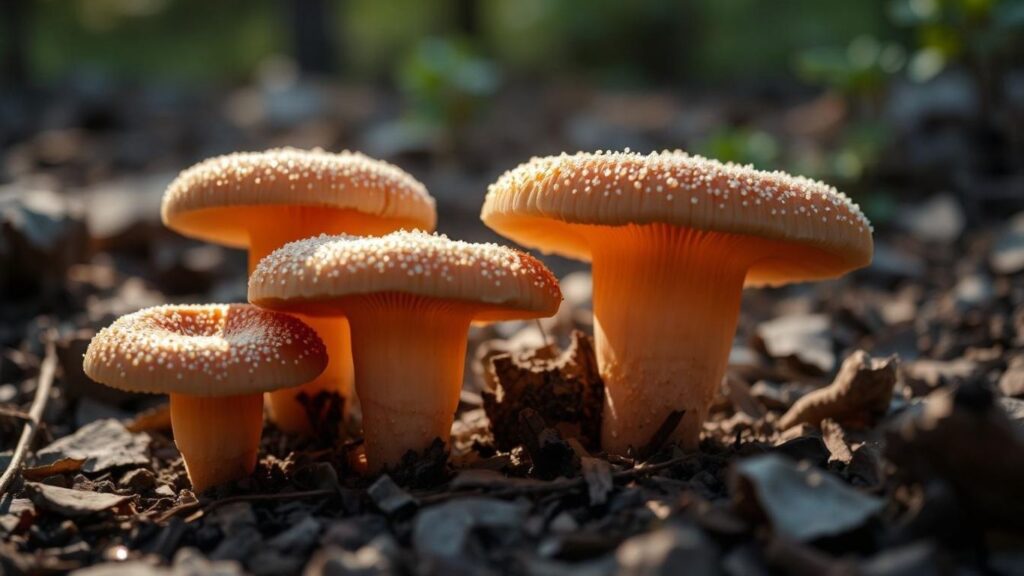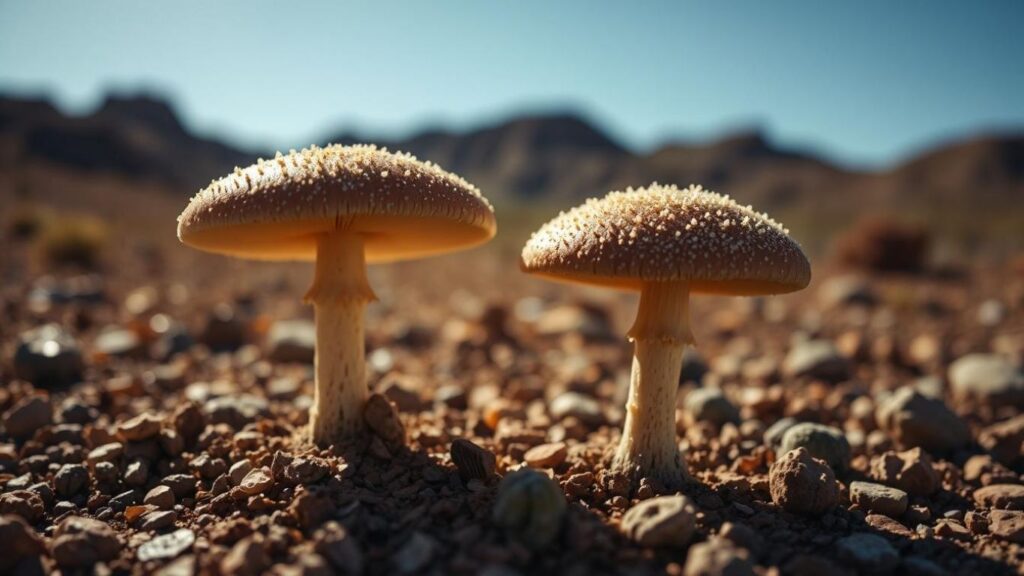Discover the Magical World of Desert Stardust Mushrooms: Nature’s Glittering Wonder

Introduction
The desert stardust mushroom is an enchanting wonder of nature, captivating the imagination of all who come across it. This unique mushroom, often found in the harshest desert environments, glows with an ethereal, bioluminescent sparkle, making it a fascinating subject for both scientists and nature enthusiasts alike. With its captivating shimmer and essential ecological role, the desert stardust mushroom represents a fascinating intersection of beauty and function in nature’s intricate web.
The glowing fungi not only bring a sense of fantasy to the desert, but they also open doors to studying extremophiles—organisms that thrive in harsh environments. Their ability to survive in such conditions may also hold clues for future research in climate adaptation and biotechnology.
What Is the Desert Stardust Mushroom?

The desert stardust mushroom (often associated with species in the genus Lycoperdon) is a bioluminescent fungus found primarily in desert environments. Known for its glittering appearance, this mushroom glows faintly in the dark, resembling stardust scattered across the night sky. It has an almost magical quality that has sparked interest in both the scientific community and folklore.
What Is a Desert Mushroom Called?
A desert mushroom, like the desert stardust mushroom, is a type of fungus that thrives in dry, arid climates. These mushrooms play vital roles in decomposing organic matter and enriching the soil. They are particularly adapted to survive in environments where most life forms struggle. Some local names also refer to them as “star fungi” or “sand glow caps” depending on the region and folklore associated with them.
Physical Characteristics
Bioluminescence and Structure
The desert stardust mushroom has a unique appearance that differentiates it from other fungi. Its outer surface is covered in tiny dust-like particles that sparkle in the sunlight or under the moon’s glow. This shimmering effect is due to the mushroom’s bioluminescence, a result of a chemical reaction involving luciferin and luciferase, which produces light in living organisms.
Size and Color
The mushroom typically grows as a small, puffball-like structure. It can range in size from 1 to 4 inches in height and features a light-colored, beige to golden exterior that glitters like stardust when light hits it. This extraordinary glow is what makes the desert stardust mushroom so remarkable in the dark desert landscapes. Occasionally, slight purple or blue hues can be seen at night, adding even more intrigue to its visual effect.
Habitat and Growth Conditions
Where Do They Thrive?
The desert stardust mushroom thrives in the arid conditions of desert ecosystems, where it benefits from the occasional rainfall and specific temperatures that allow it to grow. These mushrooms are usually found in sandy soils, often near the roots of desert plants or along dry riverbeds. Their growth is tied to moisture availability, and they are most likely to appear in the cooler months when desert moisture levels are higher.
Where Is the Mushroom Desert?
The mushroom desert refers to desert regions where fungi, including bioluminescent mushrooms, are found. These regions could include parts of North America (such as the Mojave Desert), the Middle East, and the desert areas of Australia. It’s in these areas that the desert stardust mushroom flourishes, creating an otherworldly glow in the otherwise barren landscape. Some scientists are actively mapping fungal biodiversity in these zones to better understand their ecological significance.
Ecological Importance of Desert Stardust Mushrooms
Desert mushrooms like the desert stardust mushroom have critical roles in maintaining the health of desert ecosystems. These fungi are primary decomposers, breaking down organic material such as fallen leaves, animal remains, and plant matter. This process releases nutrients back into the soil, enhancing its fertility and supporting the growth of other plants.
Their symbiotic relationships with desert plants, especially shrubs and succulents, also assist in water retention and nutrient exchange. Without fungi like the desert stardust mushroom, the desert ecosystem would struggle to maintain its balance, particularly in times of environmental stress.
Potential Health Benefits of Mushrooms

Medicinal Uses of Desert Fungi
While desert stardust mushrooms are primarily celebrated for their unique appearance, mushrooms in general have been known for their health benefits. Many types of mushrooms, such as reishi or shiitake, are rich in antioxidants, vitamins, and immune-boosting properties. Though desert stardust mushrooms have not been widely researched for medicinal purposes, many desert fungi contain compounds that can support human health.
Which Mushroom Gummies Are Best?
For those interested in the health benefits of mushrooms, mushroom gummies can provide a convenient way to consume fungi. The best mushroom gummies are often made from medicinal mushrooms like lion’s mane, reishi, or chaga, which are known for their cognitive and immune-boosting properties. These products are often vegan, gluten-free, and come with added adaptogens for overall wellness.
The Mystery of Its Glow: Is It Magic or Science?
The desert stardust mushroom’s ability to glow in the dark has inspired many myths and stories. Some cultures believe that the glow is a mystical property that brings good fortune or wards off evil spirits. Ancient desert tribes have even used the mushrooms in ceremonial settings to guide night rituals or mark sacred paths.
Scientific Explanation of Bioluminescence
However, the scientific explanation behind this bioluminescence is simple yet fascinating. Bioluminescence in fungi occurs as a result of a chemical reaction involving the enzyme luciferase, luciferin, and oxygen. This process, which produces light, is thought to attract insects that help disperse the mushroom’s spores. The glow is not a mystical phenomenon, but it does add to the allure and mystery of this desert fungus.
How to Find Desert Stardust Mushrooms
Tips for Spotting Them
Finding the desert stardust mushroom requires patience and a bit of luck. These mushrooms typically appear in desert environments after rainfall, especially in sandy or well-drained soils. If you are looking to spot one, it’s best to head out during the cooler months when moisture is higher, and the glow of the mushrooms will be most visible at night. Bring a flashlight and check near desert plant clusters for the best chance of discovery.
What Is a Mushroom Rock in the Desert?
Mushroom rocks, also known as “hoodoos” or “fairy chimneys,” are rock formations that resemble the shape of mushrooms. While these are not fungi, they share the distinctive mushroom-like shape found in the desert. They are often found in arid regions, particularly in places like Utah and Arizona, where the desert stardust mushroom may also be found. Their whimsical shapes contribute to the magical experience of desert exploration.
Preservation and Conservation Efforts
The desert stardust mushroom faces a range of environmental threats, particularly from climate change and habitat destruction. As desert ecosystems become more vulnerable, conservation efforts are crucial to preserving these unique fungi. Protecting the fragile desert habitats where these mushrooms thrive is essential to maintaining biodiversity and ensuring that species like the desert stardust mushroom continue to flourish.
Organizations focused on fungal conservation are beginning to recognize the importance of desert species. Initiatives are being developed to educate the public, promote citizen science projects, and designate fungal hotspots as protected regions.
Fascinating Facts About Desert Stardust Mushrooms

- The desert stardust mushroom is sometimes referred to as a “fairy mushroom” due to its shimmering glow.
- It can be found in desert regions such as the Mojave Desert and parts of the Middle East.
- Unlike other bioluminescent mushrooms, the desert stardust mushroom’s glow is particularly visible in desert environments, where it contrasts sharply against the dark, barren landscape.
- These mushrooms are indicators of a healthy desert ecosystem, playing vital roles in soil fertility.
- Some researchers believe they may hold biotechnological potential due to their resilience and luminescence.
Mushroom and Mushroom Rock FAQ
General Mushroom Questions
Q: What is a desert mushroom called?
A: One desert mushroom is Podaxis pistillaris, commonly called the desert shaggy mane or simply Podaxis, often found in arid regions.
Q: Which type of mushroom is best?
A: It depends on the purpose—Lion’s Mane for brain health, Reishi for immunity, and Shiitake or Portobello for culinary use.
Q: Which mushroom is healthiest?
A: Lion’s Mane, Reishi, and Chaga are among the healthiest due to their antioxidant, anti-inflammatory, and immune-boosting properties.
Q: What is the tastiest mushroom to eat?
A: Many consider Morels and Porcini to be the most flavorful mushrooms.
Q: Which mushroom is high in demand?
A: Shiitake, Maitake, and Lion’s Mane are currently in high demand, especially in the health and wellness industry.
Q: Which mushroom is the most expensive?
A: European White Truffle is the most expensive mushroom, fetching thousands of dollars per pound.
Q: Which is the rarest mushroom to eat?
A: Yartsa Gunbu (caterpillar fungus) is one of the rarest and most expensive edible fungi.
Q: Which is the king of mushrooms?
A: Porcini (Boletus edulis) is often referred to as the “King of Mushrooms” due to its rich flavor and popularity.
Q: Which is the luckiest mushroom?
A: The Amanita muscaria (red with white spots) is traditionally seen as a symbol of good luck in various cultures.
Q: Is a mushroom a vegetable?
A: Technically, no—mushrooms are fungi, not plants, but they are categorized as vegetables for culinary purposes.
Q: Is a mushroom healthy?
A: Yes, mushrooms are low in calories, rich in vitamins (like B and D), and contain antioxidants and fiber.
Q: Is a mushroom halal in Islam?
A: Yes, mushrooms are halal and permissible to eat in Islam.
Mushroom Gummies
Q: Which mushroom gummies are best?
A: Top-rated mushroom gummies include Real Mushrooms, Genius Mushrooms, and Troomy Nootropics (Lion’s Mane, Reishi, Chaga blends).
Q: What are the side effects of mushroom gummies?
A: Possible side effects include digestive upset, drowsiness, or allergic reactions depending on the type of mushroom used.
Q: Which gummies are the strongest?
A: Potency depends on active mushroom extract concentration. Lion’s Mane or Reishi gummies with high beta-glucan content are considered strong.
Mushroom Rocks and Landforms
Q: What is a mushroom rock in the desert?
A: A mushroom rock is a naturally occurring rock formation shaped like a mushroom, typically formed by wind erosion.
Q: What is another name for mushroom rock?
A: It’s also called a rock pedestal or pedestal rock.
Q: What is the most famous mushroom rock?
A: The Mushroom Rock State Park in Kansas, USA, features iconic examples of mushroom rocks.
Q: How old is the mushroom rock?
A: Many mushroom rocks are millions of years old, shaped slowly by natural erosion processes.
Q: In which desert are the mushroom rocks of the mushroom?
A: Notable mushroom rocks are found in the White Desert, Egypt, and Wadi Rum, Jordan.
Q: Where is the mushroom desert?
A: The White Desert in Egypt is nicknamed the “Mushroom Desert” due to its surreal, mushroom-shaped rock formations.
Q: Where is the largest mushroom in the world?
A: The largest is a honey fungus (Armillaria ostoyae) in Oregon’s Malheur National Forest, spanning over 2,385 acres.
Q: Where is the mushroom famous?
A: Mushrooms are especially famous in Japan, Italy, China, and France for culinary and medicinal uses.
Q: Where is the best mushroom?
A: Italy and France are known for culinary mushrooms, while Japan leads in medicinal mushroom cultivation.
Q: In which country is it famous?
A: Mushrooms are especially famous in Japan, China, Italy, and France.
Q: Which country is best for mushrooms?
A: China is the largest producer, but Japan, Italy, and France are highly regarded for quality and variety.
Mushroom Symbolism & Emojis
Q: What does the 🍄 mean?
A: The mushroom emoji (🍄) typically symbolizes nature, fantasy (like Mario), or psychedelics. It can also represent good luck or magic.
Q: What is a lucky mushroom?
A: The red-and-white Amanita muscaria is often seen as a symbol of good fortune, especially in European folklore.
Q: What do the following emojis mean 🍆 👅 💦?
A: These emojis are often used together as sexual innuendos:
- 🍆 = penis
- 👅 = licking
- 💦 = ejaculation or arousal
Q: What does the 🎗️ mean?
A: The 🎗️ emoji symbolizes awareness or support, often for causes or diseases, depending on ribbon color.
Q: What does the 🥀 mean?
A: The 🥀 emoji represents a wilted rose, often conveying sadness, heartbreak, or loss.
Q: What does 🍆🍑🍌 mean?
A: These are used as suggestive symbols:
- 🍆 = penis
- 🍑 = butt
- 🍌 = penis or phallic shape
Q: What does 👉 👈 mean from a girl?
A: This combination often expresses shyness, nervousness, or flirtation.
Q: What does 🍒 mean from a girl?
A: It can symbolize innocence, flirtation, or breasts, depending on the context.
Q: What does 🖤🖤🖤 mean?
A: Triple black hearts can symbolize deep love, gothic style, or emotional darkness.
Q: What does the 👑👑 mean?
A: Double crowns can mean royalty, confidence, or calling someone a queen/king.
Q: What does 🎀 mean from a girl?
A: The 🎀 emoji often implies cuteness, femininity, or wanting to look sweet or pretty.
Special Mushrooms
Q: What is a Japanese mushroom?
A: Popular Japanese mushrooms include Shiitake, Enoki, Maitake, and Shimeji.
Q: What is a milky mushroom?
A: Milky mushroom (Calocybe indica) is a white edible mushroom popular in India for its high yield and nutrition.
Q: Is Podaxis edible?
A: Podaxis pistillaris is not commonly eaten and its edibility is debated—it’s mainly studied for medicinal potential rather than cuisine.
Q: Is anjeer non-veg?
A: Anjeer (fig) is veg, but it may contain dead wasps due to its pollination method, which concerns some vegetarians.
Conclusion
The desert stardust mushroom is a stunning testament to the wonders of the natural world. Its shimmering, bioluminescent glow is not only mesmerizing but also serves a vital ecological function. These mushrooms play crucial roles in desert ecosystems by breaking down organic matter and enriching the soil. As one of nature’s most beautiful and mysterious organisms, the desert stardust mushroom continues to capture the imagination of people across the world.
READ MORE ARTICLES Buzznewsdaily




